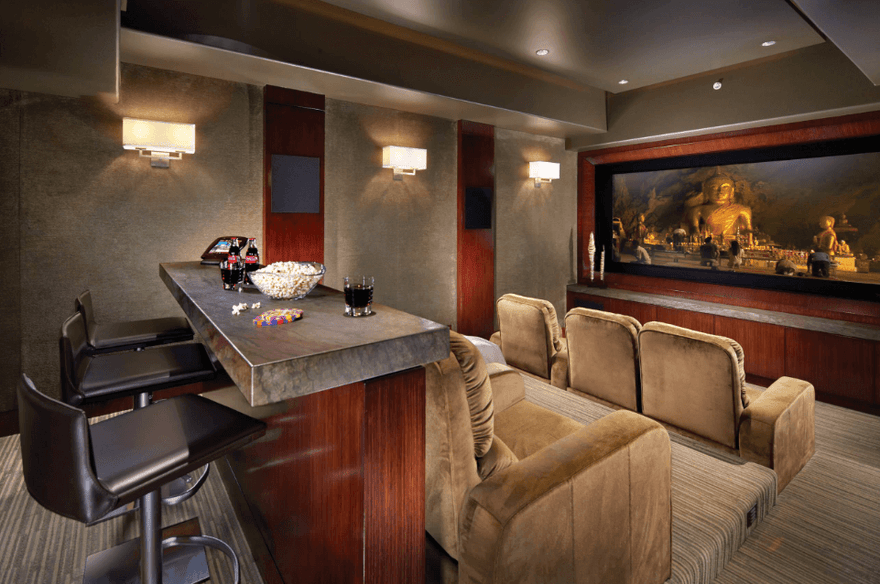Opening Hook
When Omar finally finished building his basement home theater in Dubai, he proudly invited his friends over for a movie night. The screen was massive, the surround sound was crystal clear, and the popcorn machine was working overtime. But within ten minutes, a problem became painfully obvious—half the guests were craning their necks, the back row couldn’t see past the front seats, and nobody was truly comfortable. His dream theater had the right tech but the wrong seating layout.
It’s a mistake many homeowners make. The truth is, a theater room is only as good as its seating arrangement. If you can’t see comfortably or feel immersed in the experience, even the best projector won’t save the show. So, how do you design the perfect seating layout for a theater room? Let’s walk through it together.
Why Seating Layout Matters More Than You Think
Theater seating isn’t just about chairs in a row—it’s about maximizing sightlines, acoustics, and comfort. In professional cinemas, every seat is designed so that no one’s view is blocked and the sound reaches them evenly. At home, the same principles apply.

For example, think about watching a movie from the front row at a public cinema. The screen feels overwhelming, and your neck hurts from looking up. In contrast, sit too far back, and you lose that immersive feeling. That’s why placement and layout are critical—they turn watching a movie into an experience instead of just an activity.
Read More: Where to Place TVs & Consoles in Basement Rooms
Step 1: Start with the Screen Size and Viewing Distance
Before you even choose seats, you need to know how far away they should be from the screen. A general rule is:
- The ideal distance = 1.5 to 2.5 times the diagonal size of the screen.
For instance, if you have a 120-inch screen, your seats should be between 12 and 20 feet away. Too close, and viewers strain their eyes; too far, and the sense of immersion disappears.
Furthermore, consider the viewing angle. THX recommends a 36-degree viewing angle for optimal immersion. In simple terms, you want your eyes to capture the whole screen without moving your head excessively.
Read More: Survey Report & Land Measurement Before Basement Work
Step 2: Decide on Rows and Tiers
If you’re planning more than one row of seating, elevation becomes essential. Without tiers (platforms that raise the back rows), the second row ends up staring at the back of people’s heads instead of the screen.
For example, Omar eventually solved his theater problem by adding a 10-inch riser platform for his second row of recliners. Suddenly, everyone could see clearly, and the cinematic magic returned.
As a rule of thumb:
- The first row should be on the floor.
- Second row: raise it by 8–12 inches.
- Third row (if space allows): 12–16 inches higher than the second.
This small detail transforms your theater from frustrating to flawless.
Read More: Emergency Lighting Setup for Power Outage
Step 3: Seat Types and Their Impact
Not all seats are created equal. The type of seating you choose affects both comfort and layout.
- Recliners: Luxurious, but they take up more space. Plan at least 6–7 feet of depth per row.
- Loveseats/Sofas: Cozy for families, better for smaller rooms.
- Cinema-style Chairs: Compact, efficient, great for multiple rows.
For instance, a family of four in Abu Dhabi might prefer a large sectional sofa for a casual vibe, while a movie enthusiast in Sharjah might install leather recliners with cup holders for a more authentic cinema feel.
In contrast, mixing seat types—like recliners in front and sofas in back—can create flexibility while saving space.
Read More: Library + Workspace Layouts That Inspire
Step 4: Walkways and Spacing
Comfort doesn’t stop at the seats—you also need room to move around. Nobody wants to squeeze past knees in the dark just to grab snacks.
General spacing guidelines:
- Leave at least 20–24 inches of aisle space between rows.
- Allow 6–12 inches between seats unless they’re connected recliners.
For instance, one homeowner in Jumeirah designed his theater with two wide aisles on each side, ensuring guests could move freely. The experience felt polished, almost like stepping into a boutique cinema.
Read More: Emergency Ventilation Setup for Basement Bedrooms
Step 5: Acoustics and Seat Placement
Seating layout isn’t just about visibility—it’s also about how sound travels. Speakers are carefully calibrated in theaters so everyone feels “in the middle” of the action. At home, poor seating placement can ruin this effect.
For example:
- Avoid placing the main seats directly against the back wall—sound tends to echo and boom there.
- Instead, keep the primary row about two-thirds of the way into the room. This positioning gives a more balanced sound experience.
Furthermore, stagger seats instead of placing them directly behind each other. This prevents heads from blocking both sound and sightlines.
Read More: Japanese Zen Basement Design Inspiration
Step 6: Room Shape and Layout Options
Every room has its quirks, and your seating should adapt accordingly.

- Rectangular Rooms: Best for traditional theater layouts with multiple rows.
- Narrow Rooms: Consider fewer rows with long sofas or staggered recliners.
- Wide Rooms: A curved row of seats can enhance both visibility and immersion.
For instance, in a basement theater in Al Barsha, the homeowner chose a curved recliner setup for his wide room. This meant everyone had a direct line of sight to the screen, and it created a sleek, cinematic look.
Read More: Basement Office Ideas – 11 Stylish Work From Home Spaces
Step 7: Don’t Forget Lighting and Ambience
Imagine settling into a theater seat only to be distracted by harsh overhead lights or a bright lamp reflecting on the screen. The seating layout should also work with your lighting plan.
For example:
- Place low-level LED step lights near aisles.
- Install dimmable sconces on side walls.
- Avoid light sources directly above or behind the main seats.
As a result, your guests will enjoy the movie without glare or distraction, while still having safe visibility to move around.
Read More: Homeowners’ Rights: When Municipality Rejects Your Plan
Real-Life Story: From Chaos to Comfort
Remember Omar’s first disastrous movie night? After some trial and error, he redesigned his basement theater with two rows of recliners, a riser for the second row, and a central aisle for easy access. He also shifted the first row back to the recommended viewing distance.
The next time his friends came over, the experience was completely different. No one complained about blocked views or neck pain. Instead, the group laughed, gasped, and enjoyed the film together—exactly what he’d dreamed of when building his theater.
Read More: Air Quality + Humidity Sensors in One Device: A Modern Essential
Conclusion: Designing for Experience, Not Just Aesthetics
A home theater isn’t just about having the latest technology—it’s about how you use it. The right seating layout ensures every person in the room feels part of the movie, with clear sightlines, immersive sound, and lasting comfort.
- Start with screen size and distance.
- Use risers for multiple rows.
- Choose seating types that fit your space and lifestyle.
- Leave enough space for movement and airflow.
- Consider both sound and lighting when planning.
In the end, the perfect theater room isn’t measured by the size of the screen or the brand of speakers—it’s measured by the smiles and laughter of the people seated in it.
So, before you hit play on your next blockbuster night, ask yourself: Is my seating layout ready to make this an unforgettable experience?
🏗️ Basement Project Calculator
Latest Post
-
Basement Ceiling Ideas Hide Ductwork Smartly
Opening Hook Imagine walking into your basement in Boise, Idaho—where the ceiling is so low that you brush your head on the joists—and noticing a sleek, well-designed backdrop above you instead of exposed ductwork and pipes. That difference, thanks to smart basement ceiling ideas, transforms a cramped, unfinished area into a welcoming space for movie…
-
أفكار رائعة لأرضيات رخيصة في دبي | أفضل ٢٠ خيارًا
تخيل زوجين شابين في شقة مريحة في مرسى دبي، يخطوان حافيي القدمين على أرضية أنيقة بلمسة خشبية. غرفة المعيشة تتلألأ بضوء مسائي خافت، والأرضية تحتها لا تزال تبدو جديدة تمامًا رغم سنوات من الاستخدام – وكل هذا بميزانية محدودة. هذه هي قوة اختيار أرضيات جميلة ورخيصة في دبي: الأناقة والتوفير في آن واحد. التركيز على…
-
Beautiful Cheap Flooring Ideas in Dubai | Top 20 Picks
Imagine a young couple in a cosy apartment in Dubai Marina, stepping barefoot onto a sleek, wood-look floor. The living room glows with soft evening light, the flooring beneath still looks brand-new despite years of use—and all this on a budget. That’s the power of choosing beautiful, cheap flooring in Dubai: style and savings in…



